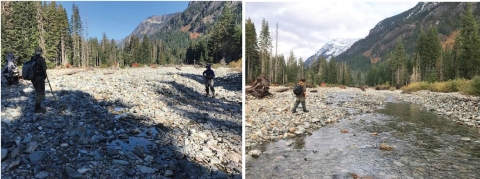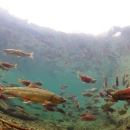States
WashingtonGold Creek in the Upper Yakima Basin historically was an important fishery for the Yakama Nation and once supported abundant stocks of bull trout, sockeye salmon, Chinook salmon, and steelhead. Now Gold Creek is designated as critical habitat for the federally threatened bull trout and is home to one of four genetically distinct populations in the upper Yakima River. Seasonal decreases in stream flow create a barrier to fish passage fish passage
Fish passage is the ability of fish or other aquatic species to move freely throughout their life to find food, reproduce, and complete their natural migration cycles. Millions of barriers to fish passage across the country are fragmenting habitat and leading to species declines. The U.S. Fish and Wildlife Service's National Fish Passage Program is working to reconnect watersheds to benefit both wildlife and people.
Learn more about fish passage for spawning adult bull trout and strand juveniles in disconnected pools of water.
The Kittitas Conservation Trust, and the U.S. Fish and Wildlife Service, along with The Confederated Tribes and Bands of the Yakama Nation, U.S. Forest Service, Yakima River Basin Integrated Water Resource Management Plan Partners, Washington Department of Fish and Wildlife, and local landowners have partnered to restore instream habitat and flows within Gold Creek. This effort will expand passage to more than eight miles of critical habitat for bull trout by improving instream flow and habitat complexity and restoring riparian riparian
Definition of riparian habitat or riparian areas.
Learn more about riparian and wetland habitat. Furthermore, by enhancing floodplain reconnection, this effort will reduce flooding risk to nearby communities and transportation infrastructure, contribute to recharging groundwater aquifers and complement ongoing work to develop terrestrial wildlife corridors across the Cascades.
Project Quick Facts:
- Location: Washington
- Federal Investments to Date: $8,000,000
- Non-Federal Investments to Date: $3,000,000
- Total restoration costs: $48,000,000
- Type of barriers: Floodplain reconnection, instream flows
- Reconstruction Techniques: Habitat/stream restoration
- Stream miles opened: 8
- Acres restored: 245
- Project Lead: Kittitas Conservation Trust
- Non-Federal Partners Include: The Confederated Tribes and Bands of the Yakama Nation, Yakima River Basin Integrated Water Resource Management Plan, State of Washington, Private Landowners, Forterra, Mountains to Sound Greenway Trust, Conservation Northwest, Trout Unlimited, Kittitas Reclamation District, Kittitas County, Mid-Columbia Fisheries Enhancement Group, Yakima Basin Bull Trout Working Group, Yakima Basin Fish & Wildlife Recovery Board
- Federal Agencies Invested to Date: U.S. Fish and Wildlife Service, Bureau of Reclamation, and U.S. Forest Service
Removing Barriers to Success
The full project objectives are to restore old gravel borrow pits to riparian and forested wetland to improve stream flow. This includes restoring instream fish habitat by installing 141 large wood structures to mimic old growth log jams, recharging groundwater aquifers, and restoring 47 acres of riparian and forested wetland habitat with native vegetation. However, only the instream restorations are currently funded and a funding gap of approximately $30 million remains. Without the efforts proposed by this project the Gold Creek population of bull trout is at risk of extirpation.
The Importance of Transformational Fish Passage Projects
This project is one of over 70 grand-scale, community-centric restoration projects, identified by the Federal Interagency Fish Passage Task Force, that not only rejuvenate ecosystems but also bolster the climate resilience and economies of communities across the country. Learn more about these ground breaking projects in our Reviving Rivers, Reconnecting Communities story map.
The National Fish Passage Program combines technical expertise with a track record of success.
Implemented primarily through the Service's Fish and Wildlife Conservation Offices, the National Fish Passage Program provides financial and technical assistance to partners across the country. Since 1999, the program has worked with over 2,000 local communities, Tribes, and private landowners to remove or bypass over 3,400 barriers to fish passage and reopen access to over 61,000 miles of upstream habitat for fish and other animals. Staff have expertise in fish migration and biology as well as financial, engineering, and planning assistance to communities, Tribes, and landowners to help them remove barriers and restore rivers for the benefit both fish and people.
Fish passage project proposals can be initiated by any individual, organization, government, or agency. However, proposals must be submitted and completed in cooperation with a Fish and Wildlife Conservation Office. (Please note that fish passage projects being used for federal or state compensatory mitigation or required by existing federal or state regulatory programs are not eligible for funding through the National Fish Passage Program.)
CONTACT A FISH PASSAGE COORDINATOR IN YOUR AREA TO GET STARTED.






